RAF Warmwell & USAAF Station 454
Airfield Site

Information
RAF Warmwell Airfield Site
Details
The Air Ministry Board needed an aerodrome in the south of England as an Armament Practice Camp. Combined with the taking over of many acres of the Fleet (Chesil Beach) as an air and ground practice range in 1937. Named RAF Woodsford after the parish, it opened with a brass band of the RAF marching from the railway station to the camp. Part of the RAF's expansion scheme due not to the rise in Germany of Hitler but that France had more bombers than we did. Three grass runways were laid out for aircraft of the No.6 Armament Training Camp. In 1938 the mix of planes were HP Harrows, Hawker Hinds, Boulton and Paul Sidestrand & Overstrands and Hawker Henley III´s. They all had their undersides painted with black and yellow stripes to donate they were target/training aircraft. They towed aerial banners behind them as targets to train pilots and gunners to shoot at.
Squadrons would fly in for summer camps to hone their bombing, air fighting skills.
Here I am covering the airfield site.

B.P. Sidestrand.

B.P. Overstrand.

H.P. Harrow.

Hawker Hind.

Hawker Henley..
RAF Warmwell Airfield Site
Information
RAF Warmwell Airfield Site
Details
Opened 1937 - Closed 1945.
RAF Officers 144. S.N.C.O.'s 160. O.R's. 1934. Total 2238.
WAAF
Officers 8. S.N.C.O.´s 10. O.R's. 284. Total 302.
RAF Sqn´s. 19, 41, 118, 130, 152, 164, 174, 175, 181, 182, 184, 234, 245, 247, 257, 263, 266, 302, 312, 350, 401, 402, 403, 411, 438, 493, 440, 443, 609, 610.
USAAF Station 454. 474th Fighter group,
428, 429 & 430.
Aircraft types: Spitfire, Hurricane, Typhoon, Whirlwind & Lightening.
Air-Sea-Rescue flight, Lysander, Walrus & Anson.
Plus many others.
RAF Warmwell Airfield Site

Record Site Plan RAF Warmwell Airfield Site 2382/46 Air Ministry
Information
RAF Warmwell Airfield Site
Details
This is the official RAF Plan of RAF Warmwell Airfield Site made in 1946 showing every hut, building, hangar, roadway, sewage works, etc, of the airfield.
July 1938 and the RAF renamed RAF Woodsford to RAF Warmwell Airfield Site, due to the fact there was another Woodsford in Cheshire. Avro Anson's of No.s206 & 220 Squadron to cover coastal patrols.

Avro Anson. Also these were made at Avro works at Woodsford.

An Anson crewing up.

Ansons turret.
RAF Warmwell Airfield Site

Record Site Plan RAF Warmwell Airfield Site 2382/46 Air Ministry
Information
RAF Warmwell Airfield Site
How to read a site plan
Details
First column is the building number - 119.
Next the description - Sleeping Shelter.
Next
the construction - P.B. Permanent Brick, T.B. Temporary Brick. T Timber. S Steel. N Nissen. Etc
Next the
drawing number - 15476/40. So it is a 15476 drawn in 1940.

T.B. Bonds.
RAF Warmwell Airfield Site

4-1-44 US 7PH LOC 138 F24
Information
RAF Warmwell Airfield Site
Details
A 1944 Air photo of the airfield taken by the USAAF. USAAF Station 454.
September 1939 and another name change (the RAF loved to change names??) No.10 Air Observation School. Then in November 1939 to No.10 Bombing and Gunnery School. Five days later it became the Central Gunnery School. This was when Fairy Battles, Whitleys, Hampden and Wellingtons arrived.

Wellington.

Whitley bomber.

Fairy Battle.

Hampden.
RAF Warmwell Airfield Site
Late 1930's
Information
RAF Warmwell Airfield Site
Details
Main 1937/38 & 39 Camp
This is a 1937 air photo showing the camp at the rear with mostly wooden hutting and in the front, the business end. An 'F' Shed aircraft hangar and a Bellman hangar. The round circle was the Compass platform to reset and test the aircraft compass.
Central Gunnery School stayed on until June 1941 when it moved to RAF Sutton Bridge.

Two Westland Wallace aircraft that flew from Warmwell.

A flight Sim of Warmwell.
RAF Warmwell Airfield Site

Record Site Plan RAF Warmwell Airfield Site 2382/46 Air Ministry
Information
RAF Warmwell Airfield Site
Details
Main 1937 Camp Area
This is the layout of the camp plan drawn in 1946 so it will have some later additions and some missing due to enemy action. Some of the hangars were destroyed in 1941 in a bombing raid so are not on the plan: -
4 A.M.W.D. Stores and compound T & C.I. Air Ministry Works Department Stores in Timber & a yard made of Corrugated Iron.
5 A.M.W.D. Garage T. T.D.1259.
10 M.T. Shed (3 section only) T. 465/37.
11 N.F.E Store (part only 15'0'' long) T. 5717/36.
13 Squadron Office (North) T. 5718/36
15 Cycle maintenance Hut T.
16 Ambulance Garage & Mortuary T. 5717/36.
18 M.T. Petrol Inst. (5,000gal) 4666/38.
27 Armoury T. 3719/36.
28 Oil Store P.B.
29 Fire Pool P.B.
30 Fire Tender House T 8632/37
31 Gas Defence Centre T. 8632/37.
35 Squadron Office (South) T. 5718/36.
36 Crew Locker Room T. 12966/36.
37 Tanker Shed T. 465/37.
38 Bulk Fuel Inst. (24,000gal) R.C. 4029/36. (R.C is reinforced concrete).
39 Station Offices T. 5719/36.
48 Telephone exchange (Main Traverse) T. 5718/36.
169 Compass Platform.
170 L.T. Standby Set House P.B. (A Power house to be used in the event of a mains power failure, probably 1936 design).
195 Main Ration Store T. 464/37.
196 Officers Quarters (A.B.&C. Scales) T. 1395/36.
Also 197 &198.
200 Squash Court P.B. 1420/37.
201 Officers Bath House and Batman´s Quarters t. 1395/36220 Medical Stores C.I.
205 Bath House 463/37.

1842/35 Squash court at RAF Netheravon may have been like the one here.

1930's RAF 'B' Timber huts.

Flight hut Biggin Hill.
RAF Warmwell Airfield Site

Late 1930's
Information
RAF Warmwell Airfield Site
Details
Airfield Site
This was the main body of the airfield, based on an RAF expansion scheme where the main hangars are the centre of the airfield and all the offices, storage, repair, MT & quarters hutting is laid out behind. This style ended by 1940 and brand new designs appeared with all the accommodation dispersed all over the countryside and here we will see this has happened. As the airfield expanded in 1940 onwards, the accommodation sites were all dispersed to the east side.

Dispersed accommodation sites.

Site No.4.

Nissen hut dispersed site on an RAF airfield.
RAF Warmwell Airfield Site

Late 1930's
Information
RAF Warmwell Airfield Site
Details
Airfield Site
'F' Shed
This type of shed (Hangar is a Shed in early RAF parlance) is an Admiralty Seaplane Shed type 'F' 2722-4/36. About 200ft long x 110ft span by 28ft high. These sheds although designed for seaplanes they were used on other land bases such as, RAF Cranwell and Rochester. On RAF Mount Batten, Devon they have two extant and the great Sunderland flying boats could just get their noses in them. RAF Cranwell and Rochester still have their Type 'F' sheds as does RAF Calshot. Calshot is a worth a visit to see hangars of this period.

Two 'F' Sheds at RAF Cranwell.

'F' Shed side elevation.

'F' Shed under construction.
RAF Warmwell Airfield Site
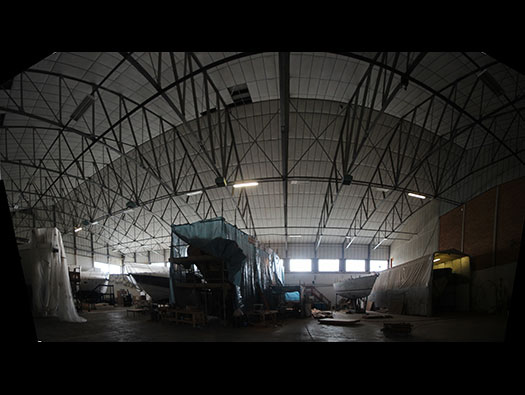
20 September 2014
Information
RAF Warmwell Airfield Site
Details
'F' Shed RAF Mount-Batten
This is inside RAF Mount Batten's F Shed..

The roof of RAF Pembrey's F shed.

RAF Pembrey re clad and used as animal pens.

Sunderland at RAF Mount-Batten.
RAF Warmwell Airfield Site

Late 1930's
Information
RAF Warmwell Airfield Site
Details
Bellman Hangar
Bellman Hangar 949/34 very early design numbers. The wooden hut on the right could be a Squadron Office (North) T 5718/36. 'T' is timber hutting. The hangar was damaged in a German air-raid and was removed when the plan of the airfield was made in 1946.

11. N.F.E. Store (part only 15'0'' long) T 5717/36.
14. Technical Latrine T 5717/36.
13. Squadron Office T 5718/36.

Wooden RAF style hut.

Squadron office 1940 style Battle of Britain .

A 1783/40 N.F.E Store of later design that you may well still find today which replaced the 1936 model.

Night flying between the wars there was very little electric lighting so N.F.E Stores held a tractor/trailer set (probably) and many Goose Neck flairs, run on paraffin and a wick through the neck and lit by some poor Erk and hen laid out as landing lights along the runway being used.
RAF Warmwell Airfield Site

25 July 1940
Information
RAF Warmwell Airfield Site
Details
Airfield Site
B - Bellman Hangars.
S - Spitfire.
W - Wellington.
H - Hurricane.
M - Miles Master.

Bellman Hangar.

RAF Old Sarum's landing T or signal Square.

RAF permanent station signal square being set out for flying.

Miles Master.

Wellington Bomber.
RAF Warmwell Airfield Site

25-7-40
Information
RAF Warmwell Airfield Site
Details
Airfield Site
This picture taken further west and the fighter pens have not yet been built but two Wellington bombers are dispersed away from the hangars.
RAF Warmwell Airfield Site

2382/46
Information
RAF Warmwell Airfield Site
Details
Airfield Site
Warmwell started as a flying field for low powered training aircraft in 1937 with the yellow area. And by 1940 the aircraft had become quite high performance and needed longer runways. Thus the red extension was added. Later the green extension for a further bomb storage area and some extra room for fighter pens to be set into woodland as camouflage was added.

Westland Wallis.

Avro Anson.

Spitfire.
RAF Warmwell Airfield Site

Chesil Beach
Information
RAF Warmwell Airfield Site
Details
Fleet Bombing & Air Firing Range
The Fleet was used by fighter planes as an air to air & ground practice firing range, also as a bombing range.
R.A.F. Personal staffed the Target Practice Range and were rowed across the Back Water by the Range Warden Mr F Randell from Chickerell. He also was responsible for putting up the red flags on the poles on the land side safety fence, before firing commenced. There were eight targets on the beach between Langton Hive and Moon Fleet House connected by a wooden plank walk with a command building in the middle.
Another R.A.F. activity was the flying of sleeve targets behind a plane and when finished were dropped on the emergency landing field to the east of Langton Cross. The firing practice used to go on day and night and later floating targets were anchored off Chickerell and New Barn.
Iris Burgin. WW2 Peoples War.

RAF Chickerell & the Fleet range.

2 x 20mm cannon shell cases from the Fleet ranges dated 1941 & 1944.

Bombing a towed sea target.

Layout of Live Bombing Target - Raft Type (16ft).
RAF Warmwell Airfield Site
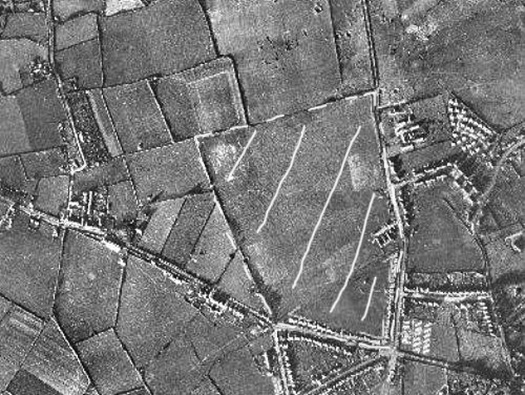
RAF Chickerell 1936
Information
RAF Warmwell Airfield Site
Details
RAF Chickerell 1936
RAF Chickerell landing ground used by RAF target towing planes from Warmwell to land and re fuel. It was not a airfield, just a small landing field with refueling capability. The target towing aircraft flew back to RAF Warmwell Airfield Site at the end of the flying day.

Westland Wallis target tug.

Target Drogue banner.
.jpg)
Drogue banner.
RAF Warmwell Airfield Site

1947
Information
RAF Warmwell Airfield Site
Details
The Fleet bombing range
In 1937, the RAF established a bombing and gunnery range along the Fleet Lagoon at Chesil Beach. In 1939, the range was extended further into Lyme Bay. The ranges were used by a variety of bombers and fighters throughout the war for their crews to improve their skills.
The idea was a plane would take off from RAF Warmwell Airfield Site, fly out to the Fleet (Chesil Beach). Formate with a target towing aircraft from RAF Chickerell. The target aircraft would have a drogue target made of cloth and the attacking aircraft bullets were dipped in dye. When the attacker hit the drogue, the colours left on the drogue told who and how many hits.
Bombing

At Lyme Regis, the RAF Marine Craft Unit was established in 1937 to provide support for the Chesil Beach Bombing Range, using fast patrol boats and safety launches.

Lyme Regis.

Bombing/ground attack targets were towed in by RAF launch and anchored in the bay and attacked by aircraft from RAF Warmwell Airfield Site. I have several cannon shells found in fields around there.

Layout of Live Bombing Target - Raft Type (16ft).
RAF Warmwell Airfield Site
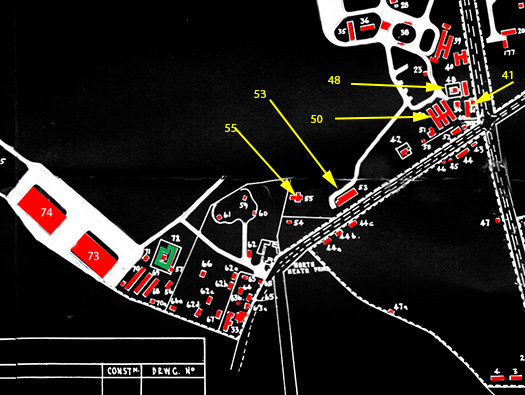
1946
Information
RAF Warmwell Airfield Site
Details
Airfield site South
This side held a mix of 1930's pre war and then in 1940's more buildings were added as for an expanding war need.
41 Signals Control Chamber P.B. W/350.
48 Telephone Exchange (Main Traverse) T. 5718/36.
50 Main Store T. 13186.39.
53 Decontamination Centre Type "G" P.B. 16690/39.
55 Machine Gun Test Butt
R.C. 4019-20/37.

Main store shelving.

Main store.

Storage.
RAF Warmwell Airfield Site

15 May 2007
Information
RAF Warmwell Airfield Site
Details
Airfield site
41 - Signals Control Chamber - P.B. - W/350.
It used to sit quite close to the road.

details

RAF phone.
RAF Warmwell Airfield Site

15 May 2007
Information
RAF Warmwell Airfield Site
Details
Airfield site
41 Signals Control Chamber P.B. W/350.
It has a blast wall with an earth travers (earth piled up around the wall to help with blast from a near miss).

Telephone exchange.
RAF Warmwell Airfield Site

15 May 2007
Information
RAF Warmwell Airfield Site
Details
Airfield site
41 Signals Control Chamber P.B. W/350.
The reinforced Permanent Brick wall with strengthening piers.
RAF Warmwell Airfield Site

15 May 2007
Information
RAF Warmwell Airfield Site
Details
Airfield site
41 Signals Control Chamber P.B. W/350.
Inside the wall.
RAF Warmwell Airfield Site

15 May 2007
Information
RAF Warmwell Airfield Site
Details
Airfield site
41 Signals Control Chamber P.B. W/350.
Control Chamber large..

RAF Telephone.

Telephone exchange.

WAAF's using teleprinters.
RAF Warmwell Airfield Site

15 May 2007
Information
RAF Warmwell Airfield Site
Details
Airfield site
41 Signals Control Chamber P.B. W/350.
Control Chamber small. Light switch was still on the wall.

Modern phone distribution box . BT.
RAF Warmwell Airfield Site

15 May 2007
Information
RAF Warmwell Airfield Site
Details
Airfield site
41 Signals Control Chamber P.B. W/350.
Looking down from the wall.
RAF Warmwell Airfield Site

15 May 2007
Information
RAF Warmwell Airfield Site
Details
Airfield site
41 Signals Control Chamber P.B. W/350.
The view looking from the west.
RAF Warmwell Airfield Site

1940
Information
RAF Warmwell Airfield Site
Details
Airfield Site
Aircraft tie downs
I was asked what the white spots were on the grass and looking into it I realised that they were aircraft tie downs to hold an aircraft down in strong winds. These you will see set into the concrete dispersed hard stands of later era airfields. But here we have them on a grass area with sunken concrete and large D steel tie.

Plan

How they would have worked.
RAF Warmwell Airfield Site

29 August 2009 Google
Information
RAF Warmwell Airfield Site
Details
Airfield Site
Aircraft tie downs
Here they are showing up on Google, seven ties to a set and at least three left.
RAF Warmwell Airfield Site
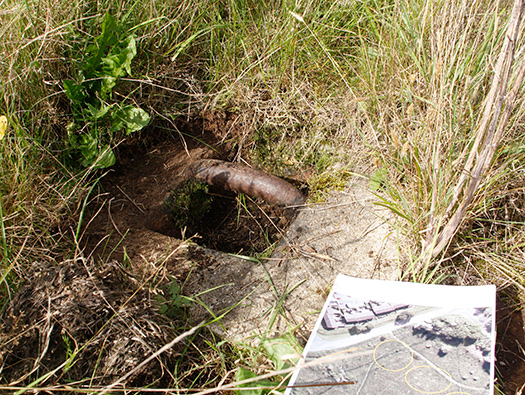
29 August 2009
Information
RAF Warmwell Airfield Site
Details
Airfield Site
Aircraft tie downs
Here the tie down is set into the grass when I found them in 2009.

How they would have worked.
RAF Warmwell Airfield Site
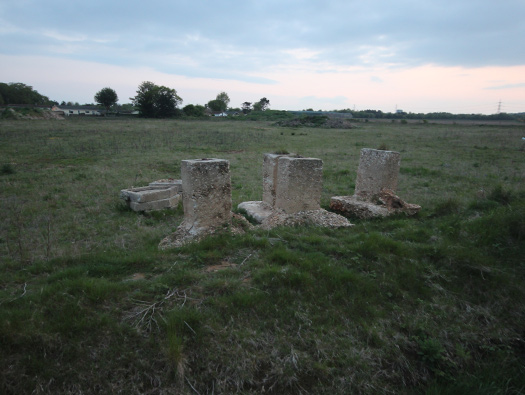
20 May 2013
Information
RAF Warmwell Airfield Site
Details
Airfield Site
Aircraft tie downs
And here they are now dug out of the ground by the developer.
RAF Warmwell Airfield Site

15 May 2007
Information
RAF Warmwell Airfield Site
Details
Airfield Site
53 - Decontamination Centre Type "G" - P.B. - 16690/41.
The railings were for gas victims who were blinded by gas to hang onto and follow into the decontamination building, where they would be stripped, washed and any wounds tidied up and fresh cloths put on. Not a nice experience.

Pembrey's 71 decontamination centre P.B. 16711/39.

WW1 gas victims.

Plan of the railings to enter undressing room. ARGARCH
RAF Warmwell Airfield Site

15 May 2007
Information
RAF Warmwell Airfield Site
Details
Airfield Site
53 - Decontamination Centre Type "G" - P.B. - 16690/41.
A bit of spaghetti pipe work remaining in 2007.

166696/39 side elevation. ARG Arch.

Plan.
RAF Warmwell Airfield Site

15 May 2007
Information
RAF Warmwell Airfield Site
Details
Airfield Site
53 - Decontamination Centre Type "G" - P.B. - 16690/41.
More pipes, asbestos and concrete.

Decontamination centre at RAF Stratford.

Parts of the heating system.

Pipe work.
RAF Warmwell Airfield Site

15 May 2007
Information
RAF Warmwell Airfield Site
Details
Airfield Site
53 - Decontamination Centre Type "G" - P.B. - 16690/41.
Remains of the hot water tank.

4538/44 Type De-scaling Feeder Unit. ARG ARCH

A hot water tank in a decontamination centre at RAF Stratford.

WW1 gas casualties.
RAF Warmwell Airfield Site

Decontamination Centre RAF Stratford 20 July 2010
Information
RAF Warmwell Airfield Site
Details
Airfield Site
53 - Decontamination Centre Type "G" - P.B. - 16690/41.
This is the RAF Stratford Decontamination Centre which looks the same as the one here.

166696/39 side elevation. ARG Arch.

166696/39 full plan. ARG Arch.

End elevation. ARG Arch.
RAF Warmwell Airfield Site

Twin decontamination Centre Type J 16696/39
Information
RAF Warmwell Airfield Site
Details
Airfield Site
53 - Decontamination Centre Type "G" - P.B. - 16690/41.
Plan. casualties would enter via the two entrances on the right and work their way through the building until released through the air lock door at the top. Wounded would use the right entrance and unwounded the left entrance.

166696/39 side elevation. ARG Arch.

166696/39 plan. ARG Arch.

Training.
RAF Warmwell Airfield Site

94118/40 ARG ARCH
Information
RAF Warmwell Airfield Site
Details
Airfield Site
53 - Decontamination Centre Type "G" - P.B. - 16690/41.
'IVO' Pressure Stabilisers to Air Ministry Spec. plan. The decontamination centre was over pressured by a large air conditioning plant. There were pressure stabilisers like this one to stabilise when a close explosions outside.
RAF Warmwell Airfield Site

15 May 2007
Information
RAF Warmwell Airfield Site
Details
Airfield Site
53 - Decontamination Centre Type "G" - P.B. - 16690/41.
Pipe fitting.

Black Ant (Lasius Niger). Adam.

From 'Typical Details of Water Supply Fittings'. Drawing Number 2040/42. Air Ministry. ARG Archive.
RAF Warmwell Airfield Site
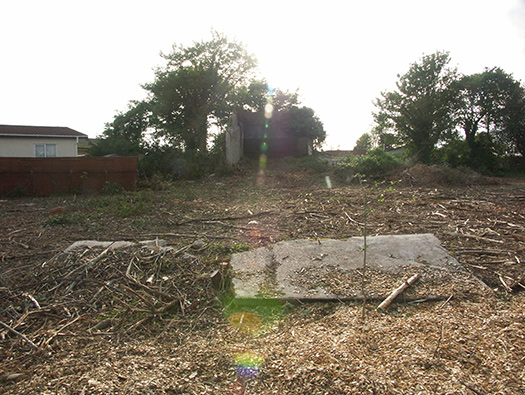
15 May 2007
Information
RAF Warmwell Airfield Site
Details
Airfield Site
55 - Machine Gun Test Butt - R.C. - 4019-20/37
Machine gun test butt, airplanes of the era of the 1930's only carried machine guns and so only needed a small butt to accept the planes one or two machine guns. Usually carried around the nose of the plane. R.C. - Reinforced concrete.

Plan

Plan of a Butt of the period at RAF Kirton-in-Lindsey.

MG test Butt P.B at RAF Hullavington. The front wall would not have been there (its now used as a shed) and a sand wall at the rear to catch the .303 bullets. RAF Church Fenton plan number is 4982 & 4983/38.
RAF Warmwell Airfield Site

15 May 2007
Information
RAF Warmwell Airfield Site
Details
Airfield Site
55 - Machine Gun Test Butt - R.C. - 4019-20/37
The left wall and sand butt.

R.C. 4019-20/37.
44a,44B,44C L.A.A. Gun Crew Accommodation P.B. & C.I
Misc 841.
54 Speech Broadcasting Building P.B. 10786/41.
53 Decontamination Centre Type "G" P.B. 16690/41.
55 Machine Gun Test Butt

The plane like Hawker Fury would have been leveled on a concrete base, tied down and the guns could fire into the butt and sites adjusted.

Linked .303 ammunition.
RAF Warmwell Airfield Site
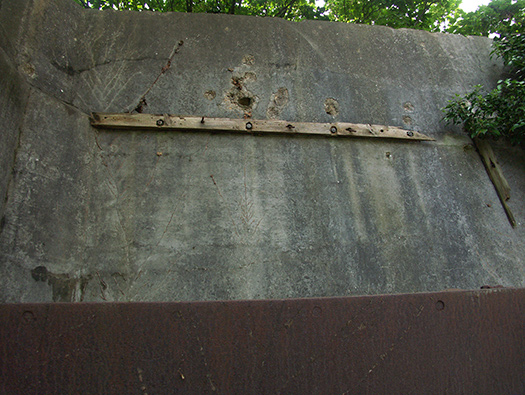
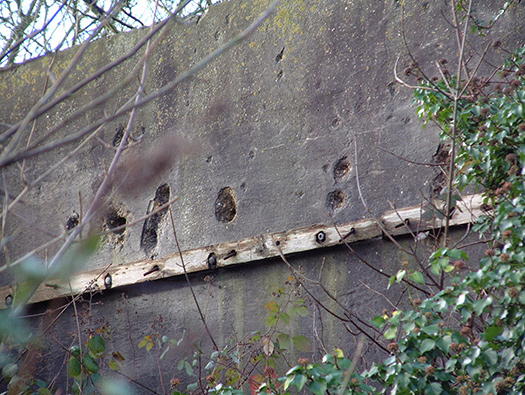
15 May 2007
Information
RAF Warmwell Airfield Site
Details
Airfield Site
55 - Machine Gun Test Butt - R.C. - 4019-20/37
Spitfires & Hurricanes would not probably have used these Butts as their guns were on the wings, this type would have been for the older bi-planes, where their machine guns were sat along the top or side of the engine.

Plan of a Butt of the period at RAF Kirton-in-Lindsey.

.303 ammunition.

A Spitfire at a cannon test butt showing how much bugger a cannon butt was.
RAF Warmwell Airfield Site

15 May 2007
Information
RAF Warmwell Airfield Site
Details
Airfield Site
55 - Machine Gun Test Butt - R.C. - 4019-20/37
Danger red flag pole.

Danger flag.

Plan.
RAF Warmwell Airfield Site

15 May 2007
Information
RAF Warmwell Airfield Site
Details
Airfield Site
55 - Machine Gun Test Butt - R.C. - 4019-20/37
The small room on the side.

Plan of a Butt of the period at RAF Kirton-in-Lindsey with the small attached hut.
RAF Warmwell Airfield Site

15 May 2007
Information
RAF Warmwell Airfield Site
Details
Airfield Site
55 - Machine Gun Test Butt - R.C. - 4019-20/37
Inside it was full of the sand from the butt.
Targets and pieces of wood to make them, nails, glue, etc. Would have been stored here.
RAF Warmwell Airfield Site

15 May 2007
Information
RAF Warmwell Airfield Site
Details
Airfield Site
55 - Machine Gun Test Butt - R.C. - 4019-20/37
One wall remains but there would have been another on this side. R.C. on the plan states it was made in reinforced concrete.

Plan.
RAF Warmwell Airfield Site

15 May 2007
Information
RAF Warmwell Airfield Site
Details
Airfield Site
54 - Speech Broadcasting House - P.B. - 10786/41
This is probably the M&E plinth to power the Speech Broadcasting House. M&E plinths were (Mechanical & Electrical) laid out around an airfield so that if mains ever failed, a generator would kick in and send power around an armoured cable that was linked to the M&E plinths. The power then would be distributed out to buildings that were important enough to use the lower power/quantity electricity.

Plan.

Armoured cable.

Brick wall that may have been around this M&E plinth..
RAF Warmwell Airfield Site

15 May 2007
Information
RAF Warmwell Airfield Site
Details
Airfield
Perimeter track from the main Airfield site across to the dispersed hangar site. Perimeter tracks on older RAF airfields were just road ways to take motor transport around the airfield and they usually followed the perimeter of the actual grass area. On later 'A' type airfields they were mainly used for the movement of aircraft from dispersed sites to the runways and were usually 50ft wide.

Plan.

'A' type airfield under construction in 1942.

Tilly light utility used by the RAF for many uses around an airfield.
RAF Warmwell Airfield Site

09 April 2003
Information
RAF Warmwell Airfield Site
Details
Airfield
Now back on the ground and the airfield itself, there are/were two Bellman hangars remaining on the south side with a Romney hut. These hangars would be ideal for the type of aircraft used here. A Wellington would fit easily into one.

Bellman hangar.

Wellington under repair.
RAF Warmwell Airfield Site

14 October 2008
Information
RAF Warmwell Airfield Site
Details
Airfield
Bellman hangar 949/34 made of a steel frame covered in corrugated iron and painted usually in black but in wartime they were camouflaged. An early type of steel hangar designed for training and fighter aircraft as it lower height of 25ft clear door height. Many examples are still around but this specific one unfortunately has burnt down unfortunately. The small brick wall was a bomb blast wall showing it to be an early model as blast walls were later dispensed with. This one has recently burnt down.

Blast wall on both sides.
RAF Warmwell Airfield Site

15 May 2007
Information
RAF Warmwell Airfield Site
Details
Airfield Bellman 73 949/34
Blast wall down the side.

Blast wall on both sides.
RAF Warmwell Airfield Site

15 May 2007
Information
RAF Warmwell Airfield Site
Details
Airfield Bellman 73 949/34
Corrugated iron sheeting held on with wing nuts to hold it on. Made as a transportable hangar, meaning it could be assembled and dis-assembled and moved very easily. The use of wing nuts, would have allowed the sheeting to be removed and replaced easily.

Bellman frame upright.
RAF Warmwell Airfield Site

15 May 2007
Information
RAF Warmwell Airfield Site
Details
Airfield Bellman 73 949/34
The door gear slowing the four doors, two each side to open and allow a fully open entrance.

Showing a Bellman with fully open doors of 90ft.
RAF Warmwell Airfield Site

15 May 2007
Information
RAF Warmwell Airfield Site
Details
Airfield Bellman 73 949/34
The other side of the hangar showing the concrete bases for the steel frame uprights. The door coming in six doors of four sections and can open to the full width.

Bellman door design.

Bellman hangar.

The six doors.
RAF Warmwell Airfield Site

15 May 2007
Information
RAF Warmwell Airfield Site
Details
Airfield Bellman 73 949/34
The view I managed inside showing the framework, the concrete walls are added by the farmer and would not have been there.
RAF Warmwell Airfield Site

15 May 2007
Information
RAF Warmwell Airfield Site
Details
Airfield Bellman 74 949/34
The second Bellman hangar 74 and a Romney hut. The Romney hut is not on the 1946 original plan and may have been placed there by the farmer post war. I believe talking to him many years ago and he said he had bought them in from another camp.

Plan of the hangars.

Plan.

Romney hut.
RAF Warmwell Airfield Site

01 June 2011
Information
RAF Warmwell Airfield Site
Details
Airfield site
100 Cannon Test Butt PB (no plan number)
In the distance on the left .
We have now arrived at the western end of the airfield.

Plan.

20mm US cannon shell 1942.

Cannon shells found by the Fleet ranges.
RAF Warmwell Airfield Site

01 June 2011
Information
RAF Warmwell Airfield Site
Details
Airfield site
100 Cannon Test Butt PB (no plan number)
Unlike the machine gun butt shown earlier this cannon butt was much larger to accommodate guns in the wings of aircraft. Also it was much stronger to accept cannon shells.

Cannon testing on a Hurricane.

Spitfire testing its guns.

Cannon test butt at RAF Charmey Down.
RAF Warmwell Airfield Site
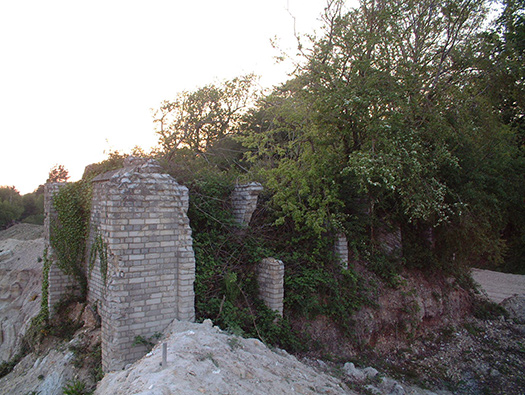
01 June 2011
Information
RAF Warmwell Airfield Site
Details
Airfield site
100 Cannon Test Butt PB (no plan number)
Looking into the front of the butt with the left wall and the individual walls that strengthens the back wall and were filled with sand to take the bullets & shells.

RAF Hurn butt showing the strengthening walls at the rear and some sand still in place.

Hurn armoured door to allow access to the rear and armoured to stop any bullets escaping if made of wood.

Mosquito blasting the sand and rear wall. The noise must have been very loud.
RAF Warmwell Airfield Site

01 June 2011
Information
RAF Warmwell Airfield Site
Details
Airfield site
100 Cannon Test Butt PB (no plan number)
The view from behind, its very hard to see what it looked like. Open at the front with protruding side walls with a rear wall with a sand butt to catch the cannon/machine gun fired ammunition and may also have a roof over to keep the sand dry..

100 the test butt where the plans sits on a concrete hard stand and is tied down and the rear is lifted up to the horizontal. The guns are then fired and adjusted to the pilots requirements.

Cannon test butt at RAF Hurn with a roof over it.

Cannon test butt at RAF Charmey Down showing the method of removing the sand to sift out cannon shells..
RAF Warmwell Airfield Site

RAF Warmwell Airfield Site Site Plan 2382/46
Information
RAF Warmwell Airfield Site
Details
Airfield Site
RAF Warmwell Airfield Site Site Plan 2382/46
This is the western side and Knighton Heath Wood
100 - Cannon Test Butt - P.B.
101 - Smith Gun & Defence Ammunition Store - P.B.
102 - S.A.A. Store - P.B.
103 - Dispersal Hut - P.B. - 6370/40.
104 - 110 Fighter type Aircraft Pens.
245 M&E Plinth.
234 - 235 Aircraft Hard-standing.
The life of a standard RAF Station of the old order suddenly changed with Hitler coming into the war and the retreat from Dunkirk. Then all hell was let loose with The Battle of Britain.

3“ Smith Gun.
The weapon consisted of a 3“ smooth-bore barrel approximately 54“ long and mounted on a carriage. It was tipped onto one end in action and was capable of firing both anti-tank and anti-personnel shells to ranges of around 300 yards. It was a heavy and awkward weapon to move around and it developed a terrifying reputation for killing its crew. The gun was not introduced until 1942 and only came with 6 shells. One of the advantages was that it could be turned over onto its wheels and towed behind a normal car or van

Smith Gun.

Smith Gun.
RAF Warmwell Airfield Site
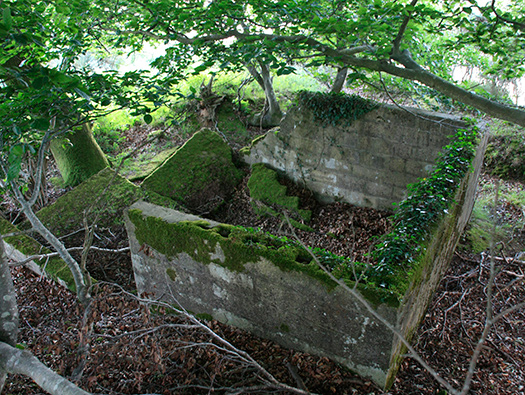
01 June 2011
Information
RAF Warmwell Airfield Site
Details
Airfield Site
101 - Smith Gun & Defence Ammunition Store - P.B.
The Smith Gun was invented by the chief engineer of the Trianco Engineering Company. It was developed as a private venture in 1940 and offered to the British Army as an emergency gun for issue to the Home Guard. At first the gun was refused by the Ordnance Board but it appears to have got into Home Guard service by some back-door route and was on issue by June 1941. It fired a modified mortar round. Here it would have been used by the defence troop to stop a parachute/glider attack on the airfield.

RAF personnel laying barbed wire.

Home Guard.
RAF Warmwell Airfield Site
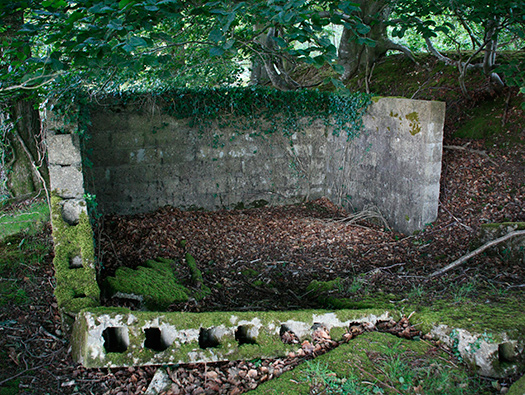
01 June 2011
Information
RAF Warmwell Airfield Site
Details
Airfield Site
101 - Smith Gun & Defence Ammunition Store - P.B.
Made of a local breeze block.
The Battle of Britain brought squadrons on Spitfires to an aerodrome not prepared for war footing. So much so that when the fighter pilots took off and fought the German hordes and landed, they went to get some food. The Group Captain in charge of the Central Gunnery School had closed the canteen on time ad refused them food if they could not keep to RAF time. Well I am not sure how long that lasted or him for that matter. As I said times were changing and the battles above Warmwell and the south coast went on for the rest of the year with Spitfire Squadrons coming and going and massive battles taking place.

Smith gun.

Plan.

RAF No.609 Squadron Auxiliary Air Force.
RAF Warmwell Airfield Site
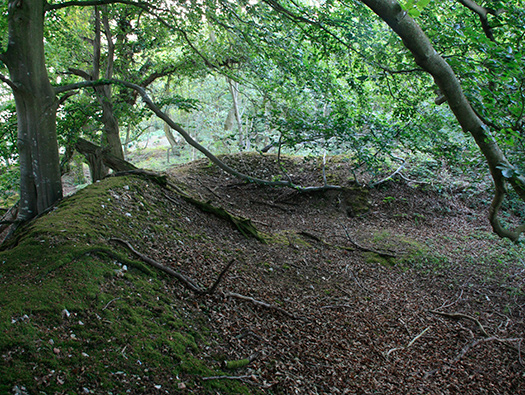
01 June 2011
Information
RAF Warmwell Airfield Site
Details
Airfield Site
105 - Fighter type Aircraft Pen
The RAF designed some very sophisticated fighter pens earlier in the war, but due to the expansion of fighter aircraft the plans went out of the window and these U shaped pens for an individual fighter were built. Here there are several left. There are no earlier Fighter Pen 11070/41 extant.

Fighter Pen 11070/41 plan.

RAF Craughton.

Plan.
RAF Warmwell Airfield Site
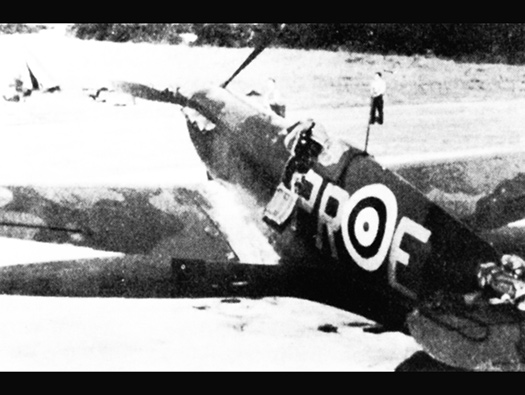
609Sqn Mk1 Spitfire
Information
RAF Warmwell Airfield Site
Details
Airfield Site
Readiness
The airfield was still just the grass runways, no fighter pens, no real infrastructure, the planes flew in from RAF Middle Wallop, landed and were immediately re fueled. Then when called for to scramble, the planes would roar off across the dry grass into action. At night they would fly back to Middle Wallop, leaving a skeleton ground crew to live in tents until a proper infrastructure could be arranged.

A & B flight at Warmwell 1940.

No. 152 (Hyderabad) Squadron RAF.

Pilot Officer Pooch. 152's mascot.
RAF Warmwell Airfield Site
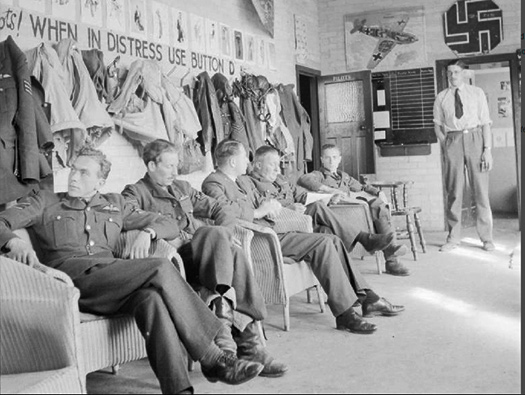
RAF Warmwell Airfield Site dispersal hut (IWM)
Information
RAF Warmwell Airfield Site
Details
Airfield Site
Squadron dispersal hut
When hutting followed a proper Squadron based hut was built. Another Spitfire Squadron that used Warmwell was No.152.
No. 152 (Hyderabad) Squadron RAF. April 1941 the airfield was attacked by three He111's killing ten airmen and a lot of damage.

152's dispersal hut.

152's dispersal hut.

152 under canvas.
RAF Warmwell Airfield Site
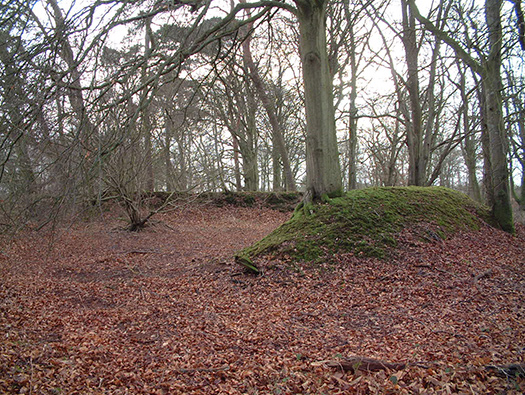
10 January 2004
Information
RAF Warmwell Airfield Site
Details
Airfield Site
Fighter type Aircraft Pen
Another further along.

Plan.
RAF Warmwell Airfield Site
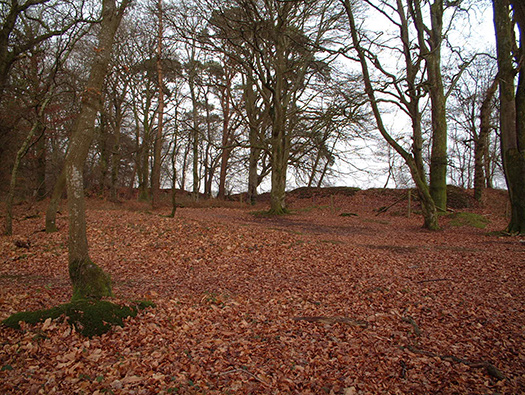
10 January 2004
Information
RAF Warmwell Airfield Site
Details
Airfield Site
Fighter type Aircraft Pen
A row of fighter pens in the front of the woodland.

Plan.
RAF Warmwell Airfield Site
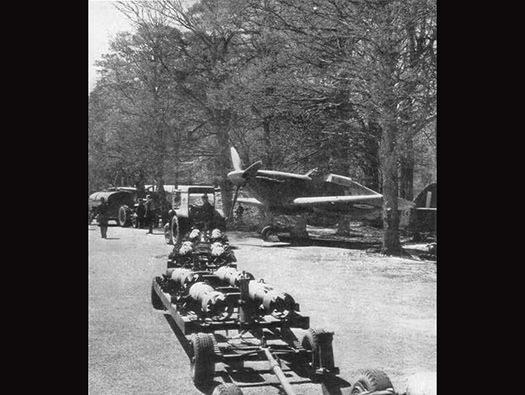
Hurribombers
Information
RAF Warmwell Airfield Site
Details
Airfield Site
Members of No.302 Squadron Polish Air Force with Hurribombers. A bomb train pulled b a tractor and in front a fuel bowser, refueling aircraft.

No.302 Squadron Polish Air Force.

Crew at dispersal.

P/O Jan Maliski
RAF Warmwell Airfield Site
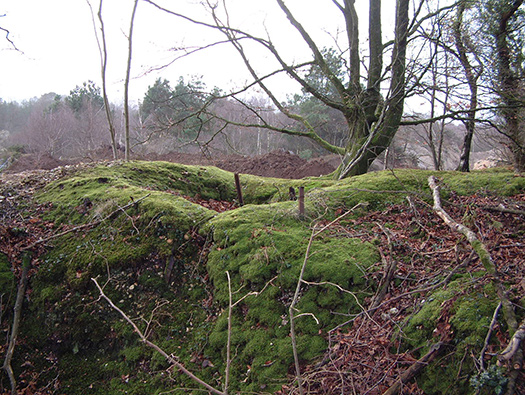
10 January 2004
Information
RAF Warmwell Airfield Site
Details
Airfield Site
This is very unusual and you hardly ever see this on any ex RAF/USAAF airfield. Many sets of slit trenches and small underground bunkers that still exist. Also picket posts and corrugated iron sheets can be seen as trench supports. Just wonder around an you will find many.

Standard plan of a slit trench.

Five Yanks in a trench.

Plan.
RAF Warmwell Airfield Site
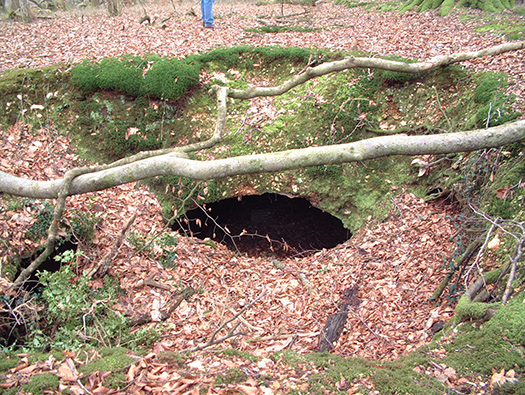
10 January 2004
Information
RAF Warmwell Airfield Site
Details
Knighton Wood
A covered trench/air raid shelter made with corrugated iron.

Plan
RAF Warmwell Airfield Site
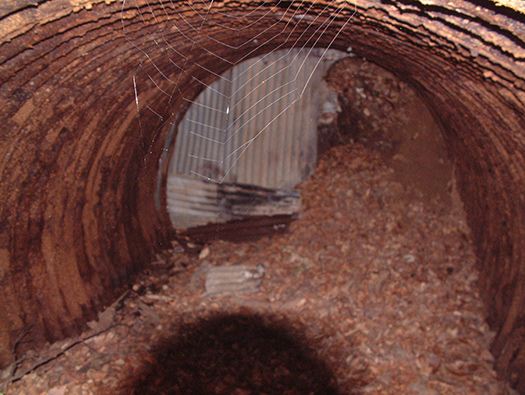
10 January 2004
Information
RAF Warmwell Airfield Site
Details
Knighton Wood
A covered trench/shelter made with corrugated iron inside.
RAF Warmwell Airfield Site
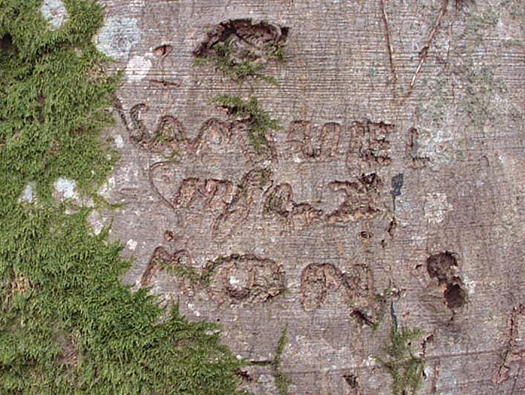
10 January 2004
Information
RAF Warmwell Airfield Site
Details
Knighton Wood
Many of threes have carvings on them.
RAF Warmwell Airfield Site
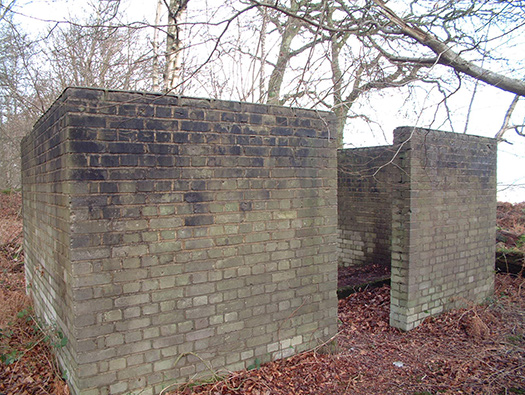
10 January 2004
Information
RAF Warmwell Airfield Site
Details
Knighton Wood
245 - M&E Plinth
M&E Plinth to distribute electricity around the airfield and transformers of some type would be inside them.

The armoured cable that would be buried around the perimeter.

Plan.
RAF Warmwell Airfield Site
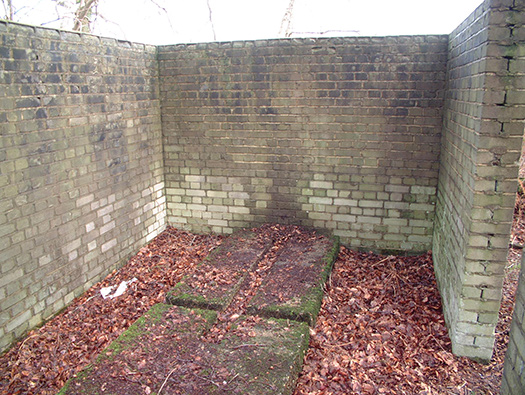
10 January 2004
Information
RAF Warmwell Airfield Site
Details
Knighton Wood
245 M&E Plinth
M&E Plinth to distribute electricity around the airfield and transformer inside with a hard base for a transformer to stand on.

Inside a plinth on an RAF airfield.

Another type.
RAF Warmwell Airfield Site
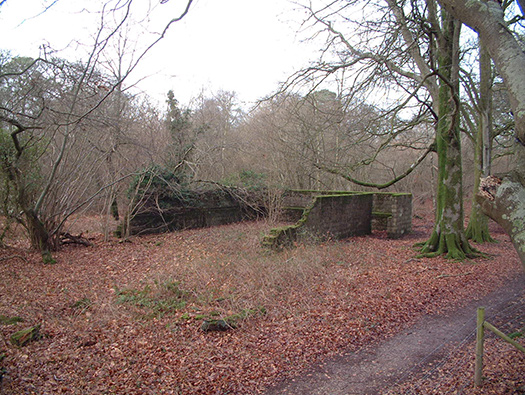
10 January 2004
Information
RAF Warmwell Airfield Site
Details
Knighton Wood
102 - S.A.A. Store P.B.
Small Arms Ammunition Store, inside the outer blast wall may have been a hut or the ammunition was stored in the open??. Note the blast wall is thicker lower down and a staggered entrance.

.303 SAA ammunition..

Re arming a fighter.

Erks making up machine gun belts for fighters.
RAF Warmwell Airfield Site

10 January 2004
Information
RAF Warmwell Airfield Site
Details
Knighton Wood
103 - Dispersal Hut - TB - 6370/40.
Dispersal hut for the fighter crews in the area.

The hut would have looked like this one.

Flight hut.
RAF Warmwell Airfield Site

14532/41 Flight Office ARG ARCH
Information
RAF Warmwell Airfield Site
Details
103 - Dispersal Hut - TB - 6370/40.
Dispersal hut for the fighter crews in the area.
A 1941 type flight office.

Danger tile.

Plan.
RAF Warmwell Airfield Site

RAF Warmwell Airfield Site Site Plan 2382/46
Information
RAF Warmwell Airfield Site
Details
Knighton Wood
Site Plan 2382/46
116 - Squadron Office - T.
119 - 120 Sleeping Shelter - P.B. - 15476/40.
121 - Bomb Fusing Point N. - 10024/41.
122 - Fused and Spare Bomb.
123 Component Store
10024/41.
124 - 125 Bomb Dump Area 12833/41.

116 Squadron Office T. 'T' timber hutting. How it may have looked.

Nissen hut fuzzing point..

120 Sleeping Shelter P.B. 15476/40.
RAF Warmwell Airfield Site
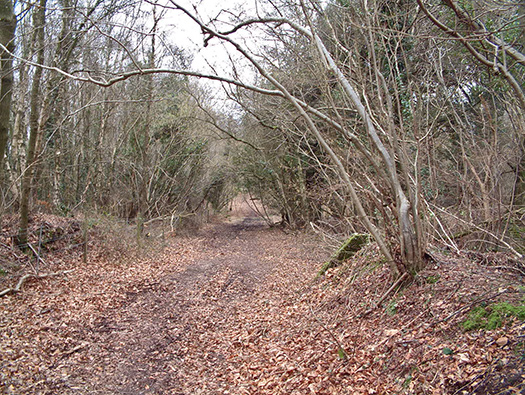
10 January 2004
Information
RAF Warmwell Airfield Site
Details
Knighton Wood
123 - Component Store -
10024/41.
This view has now changed as the woodland and earth has all been removed on the left side. On the right is the component store still to be seen.

Plan.
RAF Warmwell Airfield Site
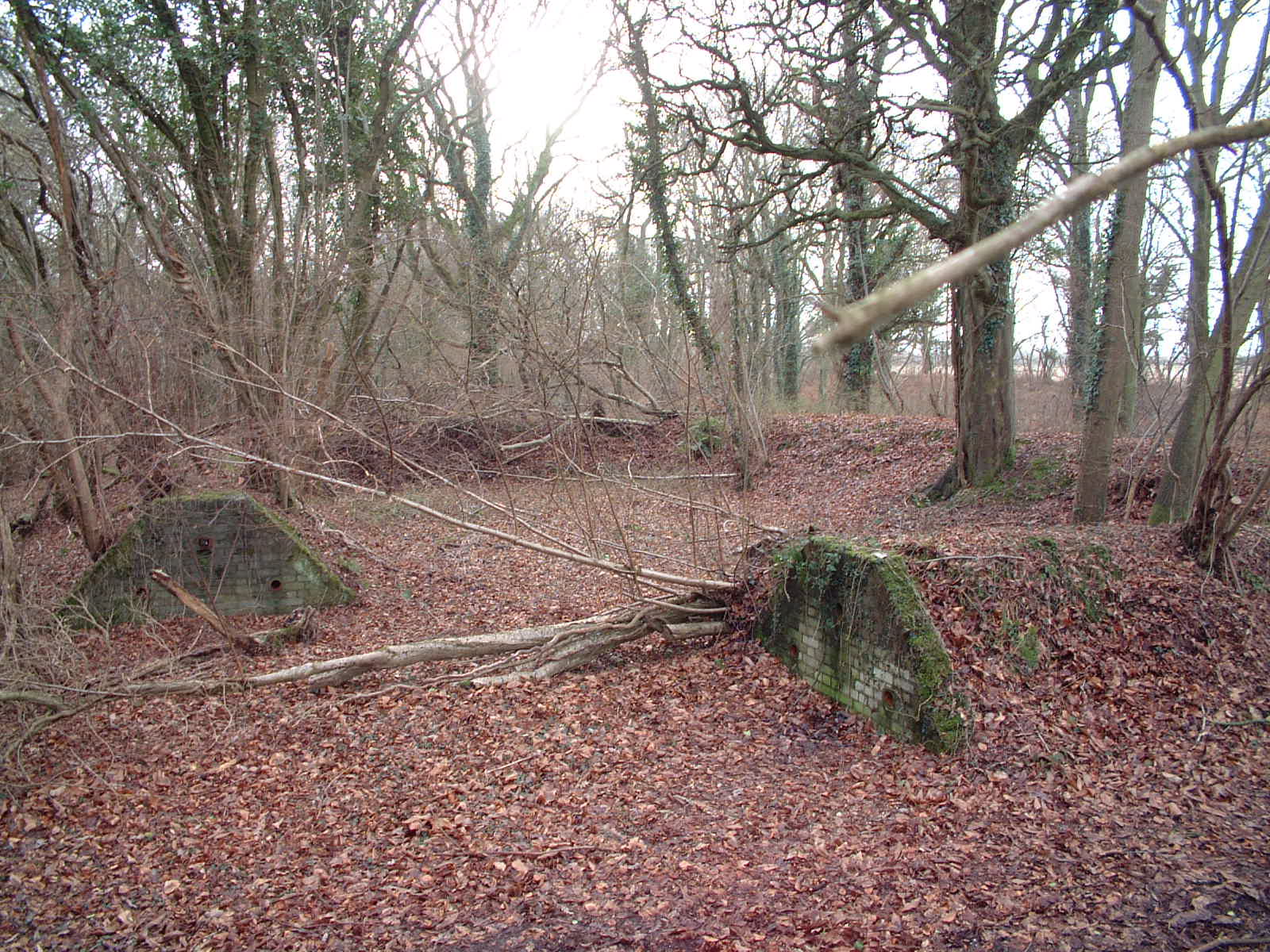
10 January 2004
Information
RAF Warmwell Airfield Site
Details
Knighton Wood
123 - Component Store -
10024/41.
Component store for bombs. As the airfield underwent a change from a small training aerodrome to having a large fighter element encroaching on it. The landing ground was extended and the fighter pens added and then a small bomb storage area for under wing bombs.

By D-Day a Spitfire could carry three bombs..

Small bomb train.

Plan.
RAF Warmwell Airfield Site

10 January 2004
Information
RAF Warmwell Airfield Site
Details
Knighton Wood
Another slit trench, one of many to be found here.

Plan.
RAF Warmwell Airfield Site
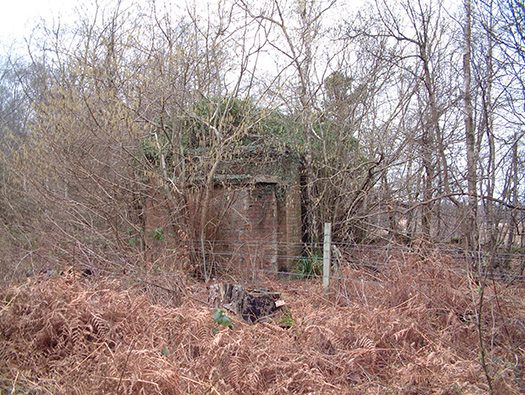
10 January 2004
Information
RAF Warmwell Airfield Site
Details
Knighton Wood
120 - Sleeping Shelter - P.B. - 15476/40.
There were two pleasing shelters here designed to hold 32men in relative comfort as a protected building. Ground crew could sleep out here over night.
I managed to get these photos before the whole site to the north of the track was dug up by the owners.

Plan.
RAF Warmwell Airfield Site
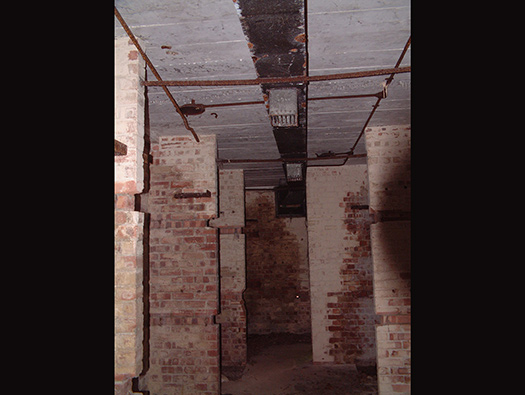
10 January 2004
Information
RAF Warmwell Airfield Site
Details
Knighton Wood
120 - Sleeping Shelter - P.B. - 15476/40.
Inside were eight bays with four tiers of bunks for 32men. They had electric lighting, and a sort of air conditioning, with electric fans in both ends.
I managed to get these photos before the whole site to the north of the track was dug up by the owners.

Inside a plinth on an RAF airfield.
RAF Warmwell Airfield Site
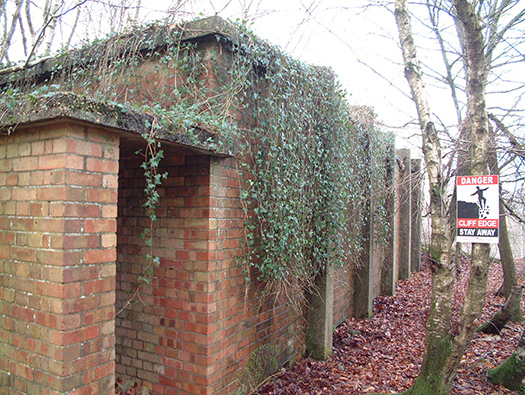
10 January 2004
Information
RAF Warmwell Airfield Site
Details
Knighton Wood
119 - Sleeping Shelter - P.B. - 15476/40.
The second pleasing shelter..
I managed to get these photos before the whole site to the north of the track was dug up by the owners.

Plan.
RAF Warmwell Airfield Site
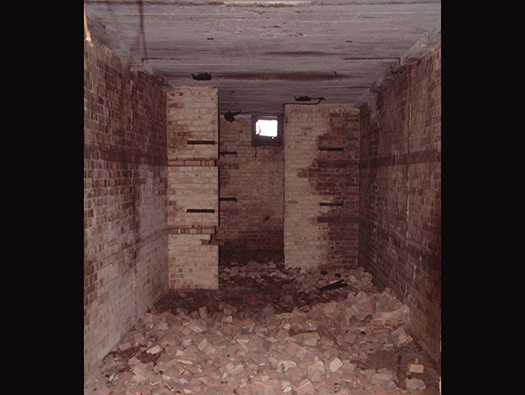
10 January 2004
Information
RAF Warmwell Airfield Site
Details
Knighton Wood
119 - Sleeping Shelter - P.B. - 15476/40.
This one was more damaged inside.
I managed to get these photos before the whole site to the north of the track was dug up by the owners.
RAF Warmwell Airfield Site

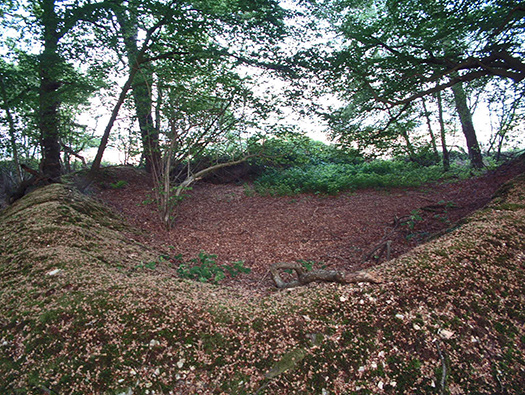
10 January 2004 - 14 May 2004
Information
RAF Warmwell Airfield Site
Details
Knighton Wood
Fighter Pen Fighter pens still extant in Knighton Wood, about eight of them. Which is really good to still have these. They were made by stacking sand bags in a shallow U shape, where a fighter style aircraft could be reversed into and it gave them some safety from a local explosion.

Plan.
RAF Warmwell Airfield Site
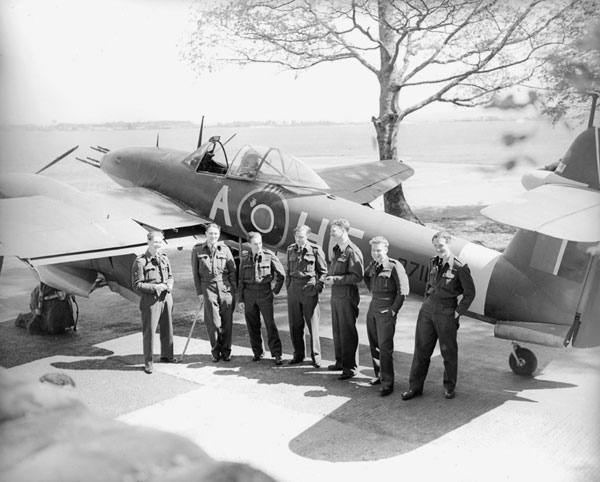
Westland Whirlwind
Information
RAF Warmwell Airfield Site
Details
Airfield Site
Fighter type Aircraft Pen
A Westland Whirlwind in one of the fighter pens in Knighton Wood. No.263 Squadron. Not a very impressive airplane, with different engines, well maybe.

No.263 Squadron RAF.

Whirlwind with HE squadron code.
RAF Warmwell Airfield Site
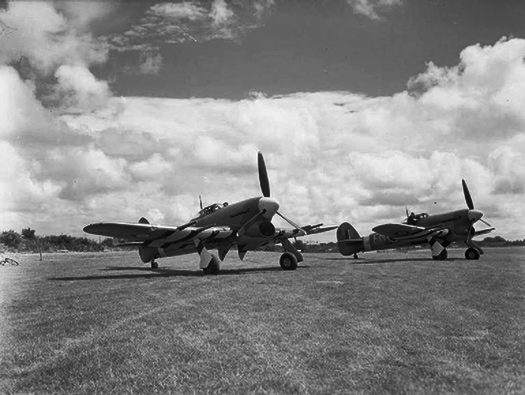
10 January 2004
Information
RAF Warmwell Airfield Site
Details
Knighton Wood
257 Sqn RAF Typhoons
Two Typhoons of 257 Sqn RAF sitting at readiness on the grass. These planes went out on many a flight across to France and bombed/cannoned and then later with rockets. German radars, V1 sites, road convoys, bunkers on the Atlantikwall.

Inside a plinth on an RAF airfield.

257 Sqn RAF.

Gun cleaning.
RAF Warmwell Airfield Site

10 January 2004
Information
RAF Warmwell Airfield Site
Details
Knighton Wood
The perimeter track ran around the front of the wood and at least seven fighter pens, back in the trees. Planes would be backed into the pens and bomb tractors and fuel bowser´s, could use the track to deliver fuel and ordnance.
September 1943 the 4th fighter Group USAAF turned up with three squadrons of P-38 Lightening´s. No's 428, 429 & 430 Sqdn's.
In June just after D-Day they all left for Normandy and ALG A-11. Air Landing Grounds had two names 'A' American and 'B' British and then numbered. A-11 was situated south of Isigny-sur-Mer.
Aérodrome ALG A-11 Saint-Lambert, Basse Normandie, France is a Facebook site of this temporary airfield.

Inside a plinth on an RAF airfield.

P-38 Lightening.

Lightening´s outside the Control tower.

4th fighter Group USAAF.
RAF Warmwell Airfield Site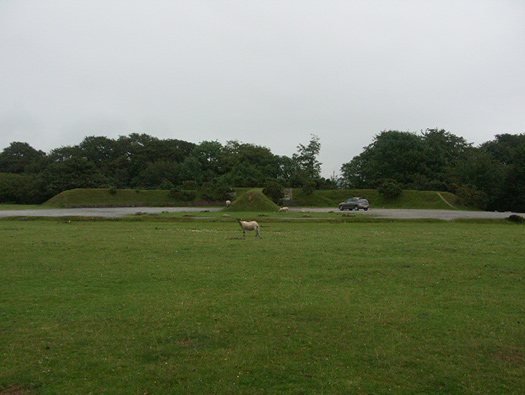

02 August 2004 RAF Harrowbeer - 06 March 2006
Information
RAF Warmwell Airfield Site
Details
RAF Harrowbeer Devon
An 11070/41 plan of 104 to 110 six standard RAF fighter pens that would have sat out on the norths side of the airfield. Now completely removed.

An RAF fighter pen 11070/41_plan.

Plan.
RAF Warmwell Airfield Site

06 March 2006
Information
RAF Warmwell Airfield Site
Details
165 & 166
Aircraft hard stand
Fighter dispersal pan/hard stand and there are two remaining of 13 that were here on the side of the road.

Plan.

Dispersal.
RAF Warmwell Airfield Site

06 March 2006
Information
RAF Warmwell Airfield Site
Details
165 & 166
Aircraft hard stand
Fighter dispersal pan/hard stand and there are two remaining of 13 that were here.

Plan.

Spitfire on a dispersal.
RAF Warmwell Airfield Site

06 March 2006
Information
RAF Warmwell Airfield Site
Details
168 - Watch Office - P.B. - 12779/41
This, now a house was the Watch Office P.B. 12779/41 that controlled the flying and was probably built in 1941/42.
RAF Warmwell Airfield Site

May 2017 Google
Information
RAF Warmwell Airfield Site
Details
168 - Watch Office - P.B. - 12779/41
M&E Plinth to distribute electricity around the airfield and transformer inside with a hard base for a transformer to stand on.

Watch Office P.B. 12779/41 Warmwell.

12779/41 front face.

343/43 first floor plan is very similar.

343/43 ground floor plan.
RAF Warmwell Airfield RAF Warmwell Airfield Site
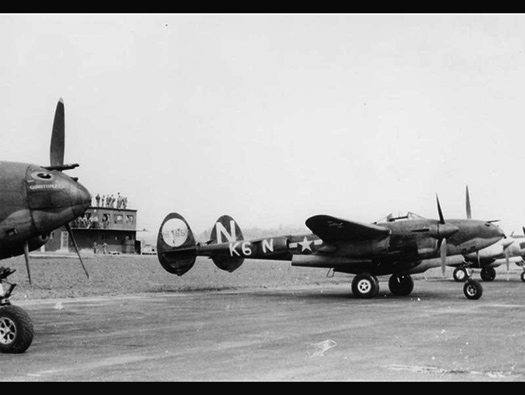
1944
Information
RAF Warmwell Airfield Site
Details
168 - Watch Office - P.B. - 12779/41
P-38 Lightening of the 430th Fighter Squadron at Warmwell before leaving for ALG A-11 Saint-Lambert, Calvados Normandie.

428th Fighter Squadron Warmwell.
RAF Warmwell Airfield Site

09 June 2011
Information
RAF Warmwell Airfield Site
Details
RAF Warmwell MENU
 Norway (coming soon!)
Norway (coming soon!)
 France
France
 Great Britain
Great Britain




























































.jpg)
























































































































































































